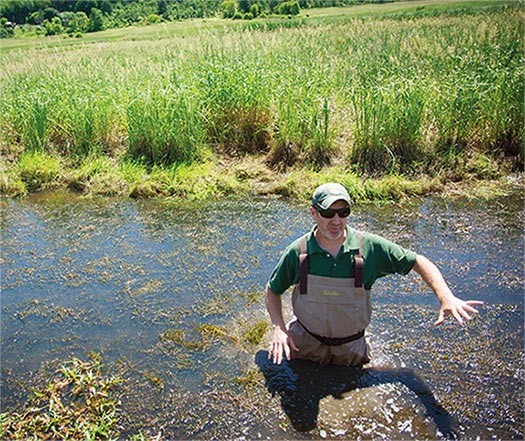
On the western side of Vermont, the Otter Creek wanders leisurely through hayfields before easing into Lake Champlain. Wildlife abounds, with shore-nesting bald eagles and ospreys, mud-scrambling reptiles and amphibians, and fish – yes, fish – all calling the floodplain home.
“Otter Creek and its tributaries often flood in the spring and fall, creating seasonal ponds within the floodplain that fill with fish,” said fisheries biologist Shawn Good. “Fish from the creek spawn in these temporary ponds, and as the floodwaters recede, they return to the main river, leaving the eggs to hatch. These ponds then function as fish nurseries where the young fish are able to grow up away from the main flow of Otter Creek, protected from predation by larger fish.”
Some of the best examples of these seasonally flooded lands can be found at Pomainville Wildlife Management Area (WMA) in Pittsford, Vermont, a place passersby could easily overlook while whizzing down busy Route 7. Much of the property consists of old hayfields sloping down from the road towards the silver maples and box elders lining Otter Creek. The Pomainville family farmed these wet fields for decades until the late 1990s, when they offered to sell the property to Vermont Fish & Wildlife.
Good first recognized the property’s potential as fish habitat after speaking with the landowner, Babe Pomainville, who was in his seventies at the time. “Babe would talk about being a kid and chasing giant pike around in six inches of water in the flooded hayfields,” said Good. “He said he would sometimes find skeletons of these huge fish out in the fields after the floods receded. When I heard that, I knew this property presented a fantastic opportunity from a freshwater-fisheries-management perspective.”
The town was not so sure. “People worried we would create a giant mosquito breeding ground in the middle of their town,” Good said. “Fortunately, the state entomologist explained that healthy wetlands actually reduce mosquito populations due to the fish, frogs, and bats eating mosquitos and their larvae. In fact, a wet reed canary grass hayfield is possibly the best place to breed mosquitos, so replacing those with healthy wetlands actually reduces mosquito populations.”
After a period of public discussion and several town meetings, Vermont Fish and Wildlife purchased the 350-acre property using funds donated by hunters and birders to Ducks Unlimited. Some eight years later, two adjacent parcels – a 60-acre riverine parcel and 150 acres of forested uplands – were added to the Pomainville WMA, which now provides 560 acres of diverse habitats.
While state fisheries biologists rarely take such an active role in land conservation, Good sees the effort to restore Otter Creek’s flood cycle as an essential fisheries-management tool. On a recent tour of Pomainville WMA, he demonstrated how the floodplain restoration effort benefits fish and other wildlife. Good drove through a hayfield with blades of grass taller than the cab of the truck, stopping at a small culvert. He pointed to what appeared to be a trickle of water running through the field and into the culvert.
“This little stream is loaded with brook trout,” he said. “It comes from a natural spring on the hillside across the road, so it stays cool year round.” He explained that brook trout need high levels of dissolved oxygen and cold water, and despite the stream’s flowing through an overgrown hayfield, wild brook trout thrive in this tiny environment.
At a seasonal pond that’s maintained on the property, Good explained that the Pomainville family dug ditches in the fields to drain spring floodwaters – a common practice among Champlain Valley farmers at the time. The state, working with the USDA’s Natural Resources Conservation Service (NRCS), unplugged the ditches and restored historical flooding patterns. They also installed water-control structures in the ditches so that biologists could manage water levels strategically.
Good was quick to show how a wetland pond in a ditch in an unshaded hayfield can support the cooler temperatures northern pike require. Wading down into the water, we could feel the water cool dramatically about 16 inches below the surface.
“Some of these ditches are six to eight feet deep,” explained Good. “The natural wetland vegetation that has recolonized the flooded areas is from seedbanks deposited here a hundred years ago or more. That, combined with their depth, keeps the waters in these ponds and ditches remarkably cold to the point that they now sustain healthy fish communities, even in the heat of summer, producing an incredible number of northern pike and other fish species for Otter Creek.”

